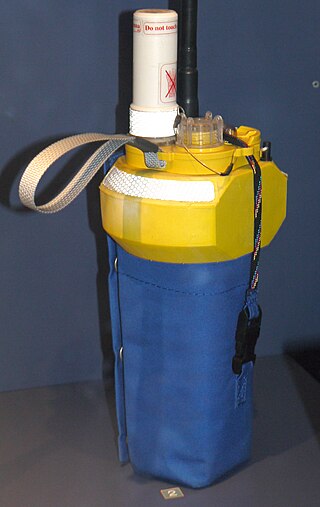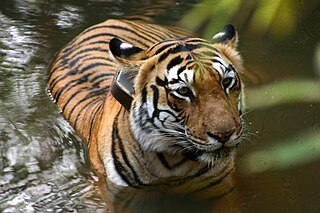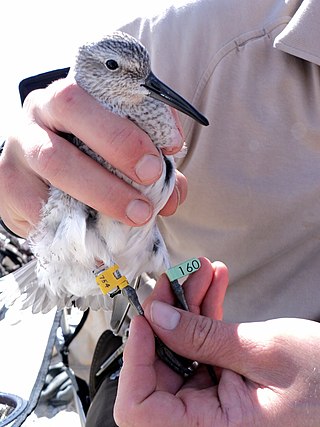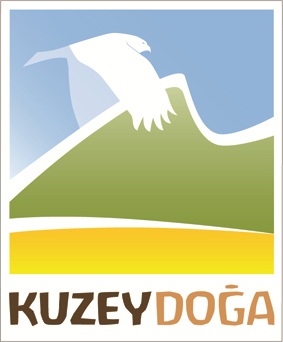
Telemetry is the in situ collection of measurements or other data at remote points and their automatic transmission to receiving equipment (telecommunication) for monitoring. The word is derived from the Greek roots tele, 'remote', and metron, 'measure'. Systems that need external instructions and data to operate require the counterpart of telemetry: telecommand.

Bird ringing (UK) or bird banding (US) is the attachment of a small, individually numbered metal or plastic tag to the leg or wing of a wild bird to enable individual identification. This helps in keeping track of the movements of the bird and its life history. It is common to take measurements and examine conditions of feather molt, subcutaneous fat, age indications and sex during capture for ringing. The subsequent recapture or recovery of the bird can provide information on migration, longevity, mortality, population, territoriality, feeding behavior, and other aspects that are studied by ornithologists. Other methods of marking birds may also be used to allow for field based identification that does not require capture.

Jason-1 was a satellite altimeter oceanography mission. It sought to monitor global ocean circulation, study the ties between the ocean and the atmosphere, improve global climate forecasts and predictions, and monitor events such as El Niño and ocean eddies. Jason-1 was launched in 2001 and it was followed by OSTM/Jason-2 in 2008, and Jason-3 in 2016 – the Jason satellite series. Jason-1 was launched alongside the TIMED spacecraft.

Argos is a global satellite-based system that collects, processes, and disseminates environmental data from fixed and mobile platforms around the world. The worldwide tracking and environmental monitoring system results from Franco-American cooperation. Besides satellite data collection, the Argos system's main feature is the ability to geographically locate the data source from any location on Earth using the Doppler effect
Biotelemetry involves the application of telemetry in biology, medicine, and other health care to remotely monitor various vital signs of ambulatory patients.

NOAA-19, known as NOAA-N' before launch, is the last of the American National Oceanic and Atmospheric Administration (NOAA) series of weather satellites. NOAA-19 was launched on 6 February 2009. NOAA-19 is in an afternoon Sun-synchronous orbit and is intended to replace NOAA-18 as the prime afternoon spacecraft.

Animal migration tracking is used in wildlife biology, conservation biology, ecology, and wildlife management to study animals' behavior in the wild. One of the first techniques was bird banding, placing passive ID tags on birds legs, to identify the bird in a future catch-and-release. Radio tracking involves attaching a small radio transmitter to the animal and following the signal with a RDF receiver. Sophisticated modern techniques use satellites to track tagged animals, and GPS tags which keep a log of the animal's location. With the Emergence of IoT the ability to make devices specific to the species or what is to be tracked is possible. One of the many goals of animal migration research has been to determine where the animals are going; however, researchers also want to know why they are going "there". Researchers not only look at the animals' migration but also what is between the migration endpoints to determine if a species is moving to new locations based on food density, a change in water temperature, or other stimulus, and the animal's ability to adapt to these changes. Migration tracking is a vital tool in efforts to control the impact of human civilization on populations of wild animals, and prevent or mitigate the ongoing extinction of endangered species.
Migration, migratory, or migrate may refer to:

Animal migration is the relatively long-distance movement of individual animals, usually on a seasonal basis. It is the most common form of migration in ecology. It is found in all major animal groups, including birds, mammals, fish, reptiles, amphibians, insects, and crustaceans. The cause of migration may be local climate, local availability of food, the season of the year or for mating.

GPS animal tracking is a process whereby biologists, scientific researchers, or conservation agencies can remotely observe relatively fine-scale movement or migratory patterns in a free-ranging wild animal using the Global Positioning System (GPS) and optional environmental sensors or automated data-retrieval technologies such as Argos satellite uplink, mobile data telephony or GPRS and a range of analytical software tools.

NOAA-17, also known as NOAA-M before launch, was an operational, polar orbiting, weather satellite series operated by the National Environmental Satellite Service (NESS) of the National Oceanic and Atmospheric Administration (NOAA). NOAA-17 also continued the series of Advanced TIROS-N (ATN) spacecraft begun with the launch of NOAA-8 (NOAA-E) in 1983 but with additional new and improved instrumentation over the NOAA A-L series and a new launch vehicle.

NOAA-18, also known as NOAA-N before launch, is an operational, polar orbiting, weather satellite series operated by the National Environmental Satellite Service (NESS) of the National Oceanic and Atmospheric Administration (NOAA). NOAA-18 also continued the series of Advanced TIROS-N (ATN) spacecraft begun with the launch of NOAA-8 (NOAA-E) in 1983 but with additional new and improved instrumentation over the NOAA A-M series and a new launch vehicle. NOAA-18 is in an afternoon equator-crossing orbit and replaced NOAA-17 as the prime afternoon spacecraft.

Geographic Information Systems (GIS) has become an integral part of aquatic science and limnology. Water by its very nature is dynamic. Features associated with water are thus ever-changing. To be able to keep up with these changes, technological advancements have given scientists methods to enhance all aspects of scientific investigation, from satellite tracking of wildlife to computer mapping of habitats. Agencies like the US Geological Survey, US Fish and Wildlife Service as well as other federal and state agencies are utilizing GIS to aid in their conservation efforts.

Pop-up satellite archival tags (PSATs) are used to track movements of marine animals. A PSAT is an archival tag that is equipped with a means to transmit the collected data via the Argos satellite system. Though the data are physically stored on the tag, its major advantage is that it does not have to be physically retrieved like an archival tag for the data to be available making it a viable, fishery independent tool for animal behavior and migration studies. They have been used to track movements of ocean sunfish, marlin, blue sharks, bluefin tuna, swordfish and sea turtles to name a few species. Location, depth, temperature, oxygen levels, and body movement data are used to answer questions about migratory patterns, seasonal feeding movements, daily habits, and survival after catch and release, for examples.
Tour de Turtles: A Sea Turtle Migration Marathon, or simply Tour de Turtles, is an annual online migration-tracking event hosted by the Caribbean Conservation Corporation. Endangered sea turtles are monitored using an attached but harmless satellite tracking device. Caribbean Conservation Corporation biologists gather satellite tracking information in order to better understand sea turtle migration patterns. Understanding sea turtle migration patterns would allow for sea turtle conservation groups to lobby for more sea turtle protection in proven areas with higher sea turtle populations. Sea turtles are the participants for the Tour de Turtle marathon. Participating sea turtles are tracked as they race to be the first to complete a 2,620-kilometre (1,628 mi) journey that is estimated to last three months. Tour de Turtles aims to increase awareness about different sea turtle species and the threats to their survival. The turtle to first swim the 1,628 miles wins the marathon.

A light level geolocator, light-level logger or global location sensor (GLS) is a lightweight, electronic archival tracking device, usually used in bird migration research to map migration routes, identify important staging areas, and sometimes provide additional ecological information. A geolocator periodically records ambient light level to determine location.

KuzeyDoğa is a Turkish conservation non-governmental organization operating primarily in the far eastern section of the country, with a focal area ranging from the shores of the Black Sea to Mount Ağrı (Ararat).
The history of wildlife tracking technology involves the evolution of technologies that have been used to monitor, track, and locate many different types of wildlife. Many individuals have an interest in tracking wildlife, including biologists, scientific researchers, and conservationists. Biotelemetry is "the instrumental technique for gaining and transmitting information from a living organism and its environment to a remote observer".

Wildlife radio telemetry is a tool used to track the movement and behavior of animals. This technique uses the transmission of radio signals to locate a transmitter attached to the animal of interest. It is often used to obtain location data on the animal's preferred habitat, home range, and to understand population dynamics. The different types of radio telemetry techniques include very high frequency (VHF) transmitters, global positioning system (GPS) tracking, and satellite tracking. Recent advances in technology have improved radio telemetry techniques by increasing the efficacy of data collection. However, studies involving radio telemetry should be reviewed in order to determine if newer techniques, such as collars that transmit the location to the operator via satellites, are actually required to accomplish the goals of the study.

Migration, in ecology, is the large-scale movement of members of a species to a different environment. Migration is a natural behavior and component of the life cycle of many species of mobile organisms, not limited to animals, though animal migration is the best known type. Migration is often cyclical, frequently occurring on a seasonal basis, and in some cases on a daily basis. Species migrate to take advantage of more favorable conditions with respect to food availability, safety from predation, mating opportunity, or other environmental factors.















